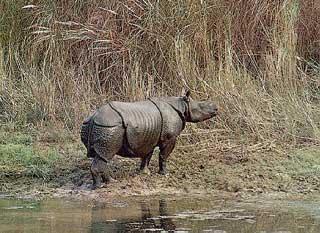|
| Query: indian rhinoceros | Result: 54th of 159 | |
Javan Rhinoceros (Rhinoceros sondaicus) - Wiki
| Subject: | Javan Rhinoceros (Rhinoceros sondaicus) - Wiki
| |

| Resolution: 320x233
File Size: 25759 Bytes
Upload Date: 2007:01:07 01:27:11
|
Javan Rhinoceros
From Wikipedia, the free encyclopedia
The Javan Rhinoceros, Rhinoceros sondaicus is one of the rarest and most endangered large mammals anywhere in the world. According to 2002 estimates, only about 60 remain alive, in Indonesia and Vietnam. Even these tiny populations are still being poached and the outlook for the species is grim. Of all the rhino species the least is known of the Javan Rhino probably due to its low numbers.
Habitat
Javan Rhinoceros are primarily found in Ujung Kulon National Park in Java. It is believed that there are still remnants of its population scattered in the rainforests of Laos, Kampuchea, and Southern Vietnam. Once widespread from Bengal eastward to include Myanmar, Thailand, Cambodia, Laos, Viet Nam, and southwards to the Malay Peninsula and the islands of Sumatera and Java. These animals prefer dense lowland rainforest, tall grass and reed beds that are plentifull with large floodplains and mud wallows. Although they like low lying areas, they have been pushed into higher ground levels (up to 2000 m) due to human pressures.
Physical features
Like the closely related larger Indian Rhinoceros, the Javan rhinoceros has only a single horn. Its hairless, hazy gray skin fall into folds into the shoulder, back, and rump giving it an armored-like appearance. The Javan rhino's body length reaches up to 10-10.5 feet(3.1-3.2 meters), including its head and a height of 6 feet tall. Adults weigh up to 3,000-4,400 pounds(1,360-2,000 kilograms). Males horns can reach 10 inches in length while in females they are knobs or no horn at all. Females however are slightley bigger than males. Like the Indian Rhinoceros it has the sharp lower incisor teeth used in fights. To chew its herbivorus diet it has two rows of broad, low crowned molars. It has the smallest ears of all rhino species and has a prehensile lip. Like other rhinos, it has very poor eyesight, but an acute sense of smell and sound.
Diet
The Javan Rhinoceros is herbivorous and eats up to 150 different plant species including shoots, twigs, young foliage, and fallen fruit. They eat 50 kilograms of food daily. It knocks down saplings to reach its food and grabs it with its prehensile upper lip. It is the most adaptable feeder of all the rhino species. Currently it is a pure browser but was probably once a more mixed (browser & grazer) eater in its historical range where it lived in more low lying areas beside watercourses.
Behavior & Reproduction
The Javan Rhinoceros is a solitary animal with the exception of breeding pairs and calves. They sometimes will congragate at salt licks and mud wallows as well. Like in all rhino species wallowing in mud is a common behavior. It cools down their tempeture and helps prevent disease and parisites. They do not dig their own mud wallow but instead wallow in pig wallows or a natural pit. Salt licks are also very important because it gives them essential nutrients. Dung marking urine spraying, scrapes and twisted saplings is used for communication but they do not spread the dung around. Instead they drag their foot for several meters even and marks scrapes with secreations of the foot gland. Male home ranges are larger at 12-20 km2 than females whcih are around 3-14 km2. Male territorys overlap other males barley while females overlap a lot. However it is not known that there are territorial fights.
The Females reach sexual maturity at 3-4 years of age while the males are at 6 years of age. Gestation occurs over a period around 16 months. The birth interval for this species is 4-5 years and the calve is weaned around 2 years. Life span of this animal is between 30 or 40 years old.
Population and Threats
Though once widespread throughout Asia, by the 1930's the rhinoceros was nearly hunted to extinction in India, Burma, Peninsular Malaysia, and Sumatra for the medical powers of its horn and blood. Now, sadly, only around 60 animals still survive and none live in captivity. The main reason for its decline is the loss of habitat because of agriculture and the poaching of its horn which is believed to have medicinal uses. Even with all the conservational efforts, the Javan rhinoceros' chance of survival is grim. Because most of the population is primarily restricted to a small area, it is very prone to disease and inbreeding. Some people would still like the last areas where they live now to be cleared for agriculture. As long as these vital areas are protected, however, this will not happen.
Subspecies
There are three subspecies of the Javan rhinoceros.
- Indian Javan Rhinoceros (Rhinoceros sondaicus inermis) (extinct)
- Vietnamese Javan Rhinoceros (Rhinoceros sondaicus annamiticus) (Vietnam only 2 - 7 animals left)
- Indonesian Javan Rhinoceros (Rhinoceros sondaicus sondaicus) (Java 50 - 60 animals left)
http://en.wikipedia.org/wiki/Javan_rhinoceros
| The text in this page is based on the copyrighted Wikipedia article shown in above URL. It is used under the GNU Free Documentation License. You may redistribute it, verbatim or modified, providing that you comply with the terms of the GFDL. |
|
Comments |
|---|
| | Guest |
|
Scientific Name: Rhinoceros sondaicus Desmarest, 1822
Common Names: Javan Rhinoceros, lesser one-horned rhinoceros, Rhinocéros de la Sonde [French], Rinoceronte de Java [Spanish] |
^o^
Animal Pictures Archive for smart phones
^o^
|
|
|